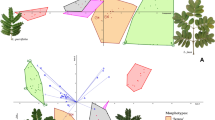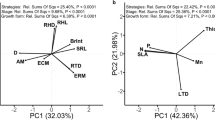Abstract
Red pine (Pinus resinosa Ait.) seedlings growing under differing levels of competition were evaluated during the fifth growing season following planting, and placed into low, moderate, or high tree classes, as a function of levels of competing vegetation. Tree growth, moisture status, and nutrition were monitored over the growing season. Additionally, site characteristics such as soil temperature and moisture, inorganic nitrogen concentration, mineralized soil nitrogen, and light were measured. Red pine seedlings growing under low competition had an absolute volume growth increase of 795% over the seedlings growing under the heaviest competition. The associated relative volume growth increase during the fifth growing season was 44%. Discriminant analysis was used to describe three classes of trees representing low, moderate, and high levels of competition. Trees growing under low competition had longer and heavier needles, but generally lower nutrient concentrations. Pre-dawn plant moisture status did not vary among competition levels. Soil variables indicated that, in general, the trees growing under low competition occupied warmer, drier, and less fertile microsites, as inorganic soil N and mean monthly mineralized NO3-N and NH4>-N tended to be lower on these microsites. The suite of independent variables was effective in classifying the model data into three tree competition classes, with percent correct classifications of 92, 75, and 100 for low (tree class one), moderate (tree class two), and heavy (tree class three) competition, respectively.
Similar content being viewed by others
References
Alban, D. H. 1984. Red pine site evaluation based on tree growth and soils, pp. 79–100. In: Marty, R. (Ed) Managing Red Pine, Proc., Society of American Foresters Region V Tech. Conference. SAF Pub. 85–02. Marquette, MI.
Armson, K. A. and van den Driessche, R. 1959. Natural root grafts in red pine (Pinus resinosaAit.). Forest. Chron. 35: 232–241.
Bassett, J. R. 1984. Red Pine Plantation Management in the Lake States: A Review. Univ. of Michigan IFSIM Pub. No. 3. Ann Arbor, MI. 27 pp.
Binkley, D., Aber, J., Pastor, J. and Nadelhoffer, K. 1986. Nitrogen availability in some Wisconsin forests: Comparisons of resin bags and on-site incubations. Biol. Fert. Soils 2: 77–82.
Brand, D. G. 1986. A competition index for predicting the vigour of planted Douglas-fir in southwestern British Columbia. Can. Jour. For. Res. 16: 23–29.
Brand, D. G. 1990. Growth analysis of responses by planted white pine and white spruce to changes in soil temperature, fertility, and brush competition. Forest Ecol. Manage. 30: 125–138.
Bremner, J. M. and Mulvaney, C. S. 1982. Nitrogen - total, pp. 643–698. In: Page, A. L. et al. (Eds) Methods of Soil Analysis, Part 2. Agronomy No. 9, Part 2. Amer. Soc. Agron., Madison, WI.
Burton, P. J. 1993. Some limitations inherent to static indices of plant competition. Can. Jour.For. Res. 23: 2141–2152.
Cole, E. C. and Newton, M. 1986. Nutrient,moisture, and light relations in 5-year-old Douglas-fir plantations under variable competition. Can. Jour. For. Res. 16: 727–732.
Day, M. W. 1941. The root system of red pine saplings. Jour. Forest. 39: 468–472.
Dierauf, T. A. 1990. Loblolly Pine Release Study. Virginia Dept. of Forestry Occasional Rep. 89. Charlottesville, VA. 12 pp.
Elliott, K. J. and White, A. S. 1994. Effects of light, nitrogen, and phosphorus on red pine seedling growth and nutrient use efficiency. For. Sci. 40: 47–58.
Johnson, J. E. 1987. Evaluation of herbicides for site preparation in central Wisconsin. North.Jour. Appl. Forest. 4: 139–142.
Johnson, J. E. 1994. The Lake States region, pp. 81–128. In: Barrett, J. W. (Ed) Regional Silviculture of the United States. John Wiley & Sons, Inc., New York.
Johnson, J. E. and Haag, C. L. 1984. Sample size for evaluating treatment effects on red pine seedlings. Tree Planters' Notes 35: 14–15.
Johnson, J. E. and Haag, C. L. 1985. Predicting the recovery of red pine stump-root biomass.North. Jour. Appl. Forest. 2: 132–134.
Johnson, J. E., Lindow, S. G. and Rogers, R. 1995. An approach to assessing competition in young red pine plantations. North. Jour. Appl. Forest. 12: 101–108.
Keeney, D. R. and Nelson, D. W. 1982. Nitrogen - inorganic forms, pp. 643–698. In: Page, A. L. et al. (Eds) Methods of Soil Analysis, Part 2. Agronomy No. 9, Part 2. Amer. Soc. Agron., Madison, WI.
Kotar, J. and Coffman, M. S. 1984. Site selection based on ecosystem classification, pp. 101–108. In: Marty, R. (Ed) Managing Red Pine. Proc., Society of American Foresters Region V Tech. Conference. SAF Pub. 85–02. Marquette, MI.
Lambert, J. L., Boyle, J. R. and Gardner, W. R. 1972. The growth response of a young pine plantation to weed removal. Can. Jour. For. Res. 2: 152–159.
Leaf, A. L. 1973. Plant analysis as an aid in fertilizing forests, pp. 427–454. In: Walsh, L. M. and Beaton, J. D. (Eds) Soil Testing and Plant Analysis. Soil Sci. Soc. Amer., Madison, WI.
Liegel, E. A., Simson, C. R. and Schulte, E. E. 1980. Wisconsin Procedure for Soil Testing, Plant Analysis, and Feed and Forage analysis. Dept. of Soil Science, Univ. of Wisconsin-Extension, Madison, WI. 51 pp.
Lindow, S. G., Johnson, J. E. and Houghton, J. E. 1989. Effects of V-Plow Machine Planting on the Distribution of Soil Nutrients. Univ. of Wisconsin-Stevens Point, Forest. Res. Rep. 89–03. Stevens Point, WI. 7 pp.
Raile, G. K. 1984. The Lake States red pine resource, pp. 6–20. In: Marty, R. (Ed) Managing Red Pine. Proc., Society of American Foresters Region V Tech. Conference. SAF Pub. 85–02. Marquette, MI.
Reed, D. D., Mroz, G. D., Leichty, H. O., Jones, E. A., Cattelino, P. J., Balster, N. J. and Zhang, Y. 1995. Above-and below-ground biomass of precompetitive red pine in northern Michigan. Can. Jour. For. Res. 25: 1064–1069.
Strothman, R. O. 1967. The influence of light and moisture on the growth of red pine seedlings in Minnesota. For. Sci. 13: 182–191.
Sucoff, E. and Hong, S. G. 1974. Effects of thinning on needle water potential in red pine. For. Sci. 20: 25–29.
Uttech, P. R. and Stier, J. C. 1986. Development Potential of Wisconsin's Red Pine Resource. Forest Resource Analysis No. 5, Pub. R3373. Univ. of Wisconsin-Madison, Madison, WI. 16 pp.
White, A. S. and Elliott, K. J. 1992. Predicting the effects of hardwood competition on red pine seedling growth. Can. Jour. For. Res. 22: 1510–1515.
Wilde, S. A., Iyer, J. G., Tanzer, C., Troutmann, W. L. and Watterson, K. G. 1965. Growth of Wisconsin Coniferous Plantations in Relation to Soils. Univ. Wisconsin Agric. Exp. Sta. Res. Bull. 262. Madison, WI. 81 pp.
Zutter, B. R., Glover, G. R. and Dickens, D. F. 1984. Competing Vegetation Assessment Systems in Young Southern Pine Plantations. Auburn Univ. Silv. Herbicide Coop. Res. Note No. 84–12. 8 pp.
Author information
Authors and Affiliations
Rights and permissions
About this article
Cite this article
Johnson, J.E., Lindow, S.G. & Rogers, R. Light, soil, and seedling characteristics associated with varying levels of competition in a red pine plantation. New Forests 15, 23–36 (1998). https://doi.org/10.1023/A:1006571130280
Issue Date:
DOI: https://doi.org/10.1023/A:1006571130280




